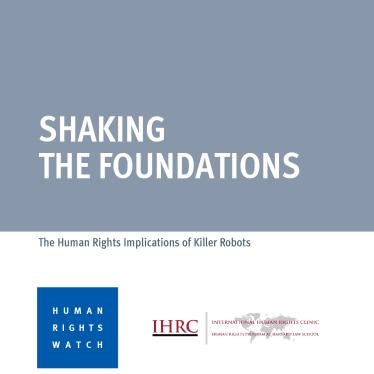The Bush Administration appears poised to resume the production of antipersonnel mines, Human Rights Watch said today in a new briefing paper.
The United States, which has not manufactured antipersonnel mines since 1997, will make a decision in December whether to begin production of a new antipersonnel mine called Spider. The Pentagon has requested a total of $1.3 billion for development and production activities for another new antipersonnel mine called the Intelligent Munitions System, with a full production decision expected in 2008.
Human Rights Watch said that these developments are the result of the Bush administration’s landmine policy announced in February 2004 under which the U.S. abandoned its long-held objective of joining the 1997 Mine Ban Treaty, which comprehensively prohibits the use, production, trade or stockpiling of antipersonnel mines.
“We are beginning to see the bitter fruit of the new Bush administration landmine policy,” said Steve Goose, director of Human Rights Watch’s Arms division. “The U.S. appears well on the way to resuming production of antipersonnel mines. Renewed export and renewed use of these inhumane weapons may not be far behind.”
The United States has not exported antipersonnel mines since 1992 and has not used them since 1991 in the Gulf War.
According to a media report which the Pentagon has yet to confirm or deny, in May 2005, the U.S. Army was to begin deploying to Iraq a new remote-controlled landmine system called Matrix, which relies on technology developed for Spider.
Human Rights Watch expressed concern that a new U.S. proposal for an international prohibition on export of landmines that do not self-destruct will pave the way for the resumption of U.S. export of antipersonnel mines that do self-destruct. A self-destructing mine blows itself up after a set period of time. For a critique of self-destructing mines, see Human Rights Watch Position Paper.
“Any future production, trade or use of antipersonnel mines would put the United States squarely at odds with the emerging international consensus against the weapon, and would draw strong criticism from its closest allies,” said Goose.
A total of 145 countries have joined the Mine Ban Treaty and another eight have signed but not yet ratified. This includes every member of NATO, as well as Japan, Australia and other key military allies. With very few exceptions, nearly every nation has endorsed the goal of a global ban on all antipersonnel mines at some point in the future. Even many states not party to the Mine Ban Treaty have stopped production, trade and use of the weapon.
Human Rights Watch said that States Parties to the Mine Ban Treaty would have to consider ending any investments they may have in U.S. companies producing or exporting the new antipersonnel mines. States Parties to the Mine Ban Treaty cannot “assist” in any way with acts that are prohibited by the treaty.
American officials have often claimed that U.S. mines are not a significant factor in the global landmine problem, and it is likely that this argument would be used in part to justify any decision to renew production of antipersonnel mines. However, the U.S. exported over 5.6 million antipersonnel mines to 38 countries between 1969 and 1992. Deminers in at least 29 mine-affected countries have reported the presence of nine different types of U.S.-manufactured antipersonnel mines and four types of antivehicle mines, including both non-self-destructing and self-destructing types.
Human Rights Watch believes that the Bush administration should reverse its decision not to join the Mine Ban Treaty, and should not insist on the right to use self-destruct antipersonnel mines indefinitely. In its briefing paper, Human Rights Watch recommends that:
- Research and development on or production of mines or munitions capable of being victim-activated should be immediately halted. Continued funding for the Spider program should be made contingent on the removal of the battlefield override feature. Continued funding for the Intelligent Munitions System should be dependent on the compliance of this program with the Mine Ban Treaty.
- The Department of Defense should publicly clarify whether the Matrix mine system has already been deployed, and if it is capable of being victim-activated. The Department of Defense should also provide details on target identification and the protections afforded civilians in areas Matrix mines are used.
- The Department of Defense should clarify current policy regarding use of Claymore mines with tripwires, and should prohibit such use everywhere, including South Korea.
- The U.S. Mine Export Moratorium should be made permanent. Any interpretations of or exceptions to the Mine Export Moratorium should be publicly disclosed, as well as what understandings the United States observes regarding the transfer of mines prohibited by CCW Amended Protocol II.
- The appropriate Congressional committees should be notified on an annual basis of any export or transfers of antipersonnel mines, regardless of the intended purposes of the mines or the number of mines.






